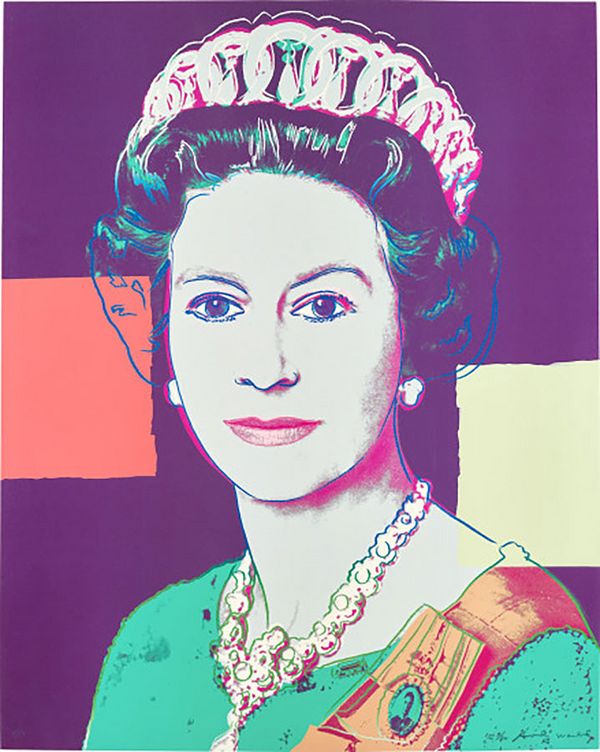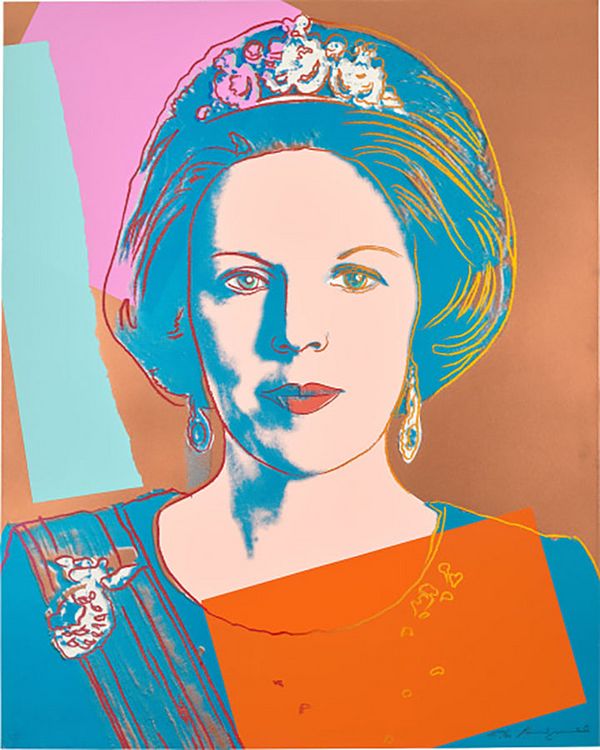Tama Janowitz and Andy Warhol, 1986. Image: Louie Psihoyos, Artwork: © 2023 The Andy Warhol Foundation for the Visual Arts, Inc. / Licensed by DACS, London
Written by Tama Janowitz
In the days of the early 80s, when I first wandered Manhattan, Andy Warhol was there too. I was nobody important, and broke, but I discovered on my wanders through the city (via 50 cent bus or on foot) that Soho was a bunch of rusting cast-iron factory buildings. Some had floors inhabited illegally by artists or were still making knitting needles, hooks, or snaps and ground floors converted to galleries. People on the warm nights gathered on the streets in front of what looked like shabby little exhibitions inside.
Andy Warhol frequently showed up, or arrived at tiny obscure storefronts in the East Village — maybe someone sent him an invite for a show of Haitian art? Or you might see him when you went to some of the little clubs and bars in other parts of the city.
He was interested in everything that was going on and especially the lives of the young people, and after I wrote my first book, American Dad, we became friends, casually, and talked when our paths crossed. He read everything. “What are you reading now, Tama? Anything good?” He had read my first book and loved it.
Then Paige Powell, the advertising director at Interview, became my friend, and she was best friends with Andy. We all went out every night, or nearly so, and met at restaurants all over the city. One of our favorites was Café Luxembourg on the Upper West Side, not far from where I lived. (Paige had traded advertising space in the magazine for $75,000 worth of meals).
At that time, Andy was the only person I’d ever met who liked dining with everybody. He didn’t care if it was movie stars, restaurateurs, ballet dancers, jewelers or young, tough street graffiti artists who jumped turnstiles at night to spray. He was interested in people.
When I first knew him, he worked in his studio at the northwest corner of Union Square (where the Interview offices were as well), until he — his painting studio, the magazine — moved up to the old Con Ed building between 31st and 32 Street. When I visited the studio there, up stairs that wound from 32nd Street to 31st, he was working on canvases that changed all the time, from African animals or portraits of socialites or glittering high heeled shoes. The whole studio — the canvases, the floor — was covered with diamond dust acquired from John Reinhold, his friend who was a jeweler. That diamond dust stuff spread everywhere.
That’s when I first met the Queen.

Andy Warhol, Queen Elizabeth II of the United Kingdom, from Reigning Queens (Royal Edition), 1985. Editions London.
Andy was excited by royalty — as much as Andy ever displayed excitement. He always said, about everything and everyone, “Oh gee, they look great!” Or, “That sounds great!” but there are about a thousand ways to say that and Andy knew every one of them. And you always knew what he actually meant when he said it.
It didn’t necessarily mean he thought something or someone was great. But it was always the perfect thing to say.
Andy Warhol died in 1987. In the long hot summer after, I bought a tiny basement apartment on West 70th Street over by West End Ave. That’s when I met Tim Hunt. A model for Werther’s Caramel and Ralph Lauren who’d gone to Oxford and had a brother who was a famous race car driver, he’d been with Christie’s a few years and had come over from England to work on the Warhol estate. He would later become my husband.
Andy would have loved Tim. But the two had never met.
It didn’t matter who was in town we knew — or who claimed they knew someone we knew. There were aspiring actors with famous parents (who later became famous) and aspiring actors who did not. There was a 23-year-old kid who was starting an investment fund that became a billion-dollar company. Some had titles, some were con artists and grifters. There were fashion designers and doctors, Germans and Russians and Australians. There were talented painters who never made it, and taxi drivers and dog walkers. It didn’t matter.
In the nearly empty city, there was the fecund smell of the ailanthus trees in bloom, or later, the city summer skunk of garbage, the fishy Hudson River. Occasionally, an illuminated blimp would float overhead on its way from New Jersey to some sporting event in an arena. Once, one sank lower and lower and at last crashed into the side of the building across the street where it deflated. No one was harmed, but the residents of those apartments must have been shocked when suddenly the view from the windows was covered over by a vast quantity of wrinkled tissue — the blimp’s skin — as if the ghostly fabric of Princess Diana’s massive wedding gown had been tossed over the building without advance warning…
That was the second time I met the Queens — at Tina Ying’s restaurant on Columbus Avenue, where Tim and I would go for dinner. All four of Warhol’s Reigning Queens hung on the walls over a big, open, clean and charming space with white tablecloths and vaguely Asian pale modern furniture. During the day, Tina was head of make-up at ABC TV, and ran her restaurant at dinner, which was something that would happen only in New York. She was beautiful, tall, and slim — and as regal as Andy’s queens.
One of Tim’s friends had a father who was (something like) ‘The Bearer of the Queen’s Privy Purse.’ I always envisioned this guy’s dad as trudging after Elizabeth carrying her handbag when she went to the toilet. For years after that, whenever I looked at a picture of her, I thought she wasn’t allowed to carry a pocketbook. But I know now, that’s not what it meant.

Andy Warhol, Queen Ntombi Twala of Swaziland, from Reigning Queens (Royal Edition), 1985. Editions London.
Most people in the City only recognized Queen Elizabeth, the others being less iconic — but I was struck to see them all there together — four powerful women monarchs from all around the world, which felt very international. And Ntombi Twala of Swaziland was black, which was nice to see. Andy made them all look great.
Tim’s friends from all over the world continued to visit NYC for pleasure or business, it seemed, every other day. Sometimes even their friends — who Tim didn’t know — came to town too. If you visit NYC and call someone, they will tell you “I’m all booked up. Busy every night. Let me know when you’re back in town.” We weren’t like that. Instead, it was, “Oh, you’re in town? A friend of so-and-so’s? Meet us at Tina Ying’s. We all go Dutch. By the way — who is so-and-so?”

Andy Warhol, Queen Margrethe II of Denmark, from Reigning Queens (Royal Edition), 1985. Editions London.
It was like that in the old days with Andy — out three nights a week, but only at our spot. Café Luxembourg was still just up the street, if someone else was paying — and you didn’t need or want to spend three or four hours chatting and talking, about art, or architecture, or outer space.
For that, you could sit out in the tiny garden in back of Tina Ying’s, where the clinking forks on ceramic meant the people were having their dinner. In the darkened apartments overlooking the pretty garden of bamboo where the occasional rat climbed up an ivy vine, people were watching the news on TV of Diana and Charles, or what was happening in Tiananmen Square, or The Cosby Show.
We were there regularly and we knew every item on the menu and ordered massive quantities — ginger chicken, Singapore rice noodles, a fish so big it needed a giant platter, sweet and sour but not gluey, with delicate flesh — it didn’t matter because everything that came from that kitchen was fresh and crisp and spicy — plus, bottle after bottle of icy Pinot Grigio or inexpensive but delicious Sauvignon Blanc.

Andy Warhol, Queen Beatrix of the Netherlands, from Reigning Queens (Royal Edition), 1985. Editions London.
Tina always there, looking happy but slightly alarmed at the staggered arrival of our party — as many as twenty or thirty. She was pleased to have customers — especially ones this glamorous (or at least so outrageously outré). But she was also aware: we were never going to leave until the restaurant closed for the night. “Hi Tama, hi Tim, how are you, great to see you!” With a slightly worried expression she escorted us to the back where the tables had been pushed together or — if there were fewer of us — to a table in the front room.
There was no Andy, scrawling his signature in black marker on a napkin to give some diner who wanted an autograph, but — under the serene gaze of Queen Elizabeth II — a certain decorum was maintained. And, with his silkscreens on the wall, it was like he had joined us for the party.
Sometimes at those crazy dinners hosted by Andy, years back — in restaurants far fancier and more expensive — we diners had flung things, such as soft white dinner rolls. Or crusty hard ones. Without Andy, you would never think of this kind of behavior.
And we laughed and talked and the smokers went outside to smoke on the sidewalk in the yellow light of the cooling street that smelled of food cooking and ripening garbage and dog urine — all the scents that make NYC in summer what it is. Then it was late, the waiters were growing restless, they had wanted to shut down at 11 and by now it was 11:30 and it was a long subway ride for these waiters all the way out to Brooklyn — and, at last, though no one wanted to leave, the long table was presented with the bill.
At Tina’s — whether we were ten, or twenty, the bill was always the same — including the vast quantities of alcohol, cocktails, beer, wine, vodka consumed by Russians and Irish, Italians and Brits, revelers visiting from around the world, and so much food — bright green pea shoots, Peking Duck, crispy Szechuan beef — each time the total always amounted to twenty-five dollars each. And that included a lavish tip.
The bill came with the fortune cookies telling each of us about our futures. Back then, there was still a lot of future in front of all of us.
But in the years to come we would all go our separate ways. In the late 80s, you bought disposable cameras and everyone took pictures to take to the pharmacy to get developed — where are all the photos now? Those crazy dinners, under the starry gaze of the colorful Reigning Queens, represent a certain moment in my life. Andy had made those pictures and he had been, in his own way, a reigning royal of New York City.
Auction /
18 – 19 January
30 Berkeley Square, London, United Kingdom, W1J 6EX (map)
Viewing /
11 – 18 January
Monday-Saturday 10:00am-6:00pm GMT
Sunday 12:00pm-6:00pm GMT
Discover More from Editions London >
Recommended Reading
Devoted to Dachshunds: Artists and their Pets >
Picasso’s Media and Muses: Forty Years, Four working methods, Three Wives and Lovers >
